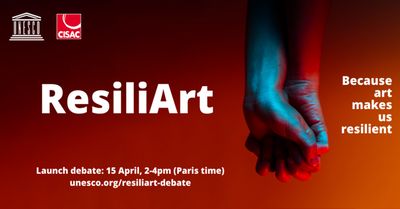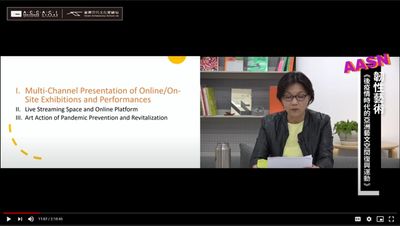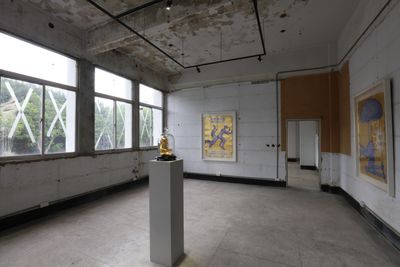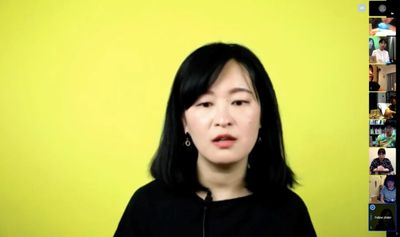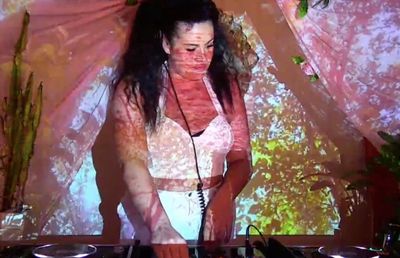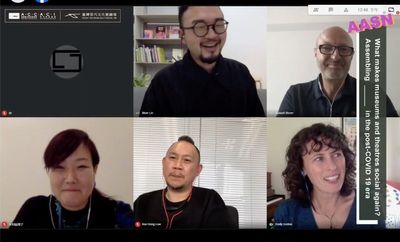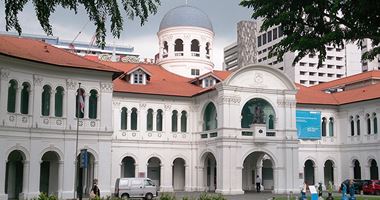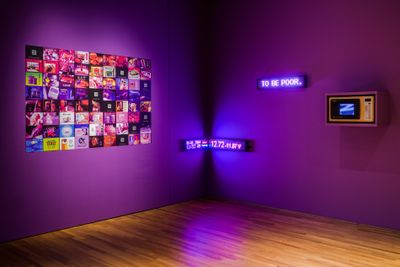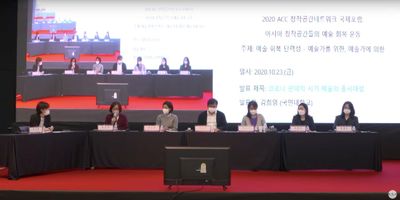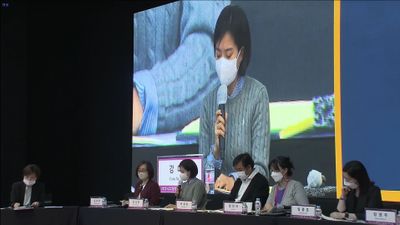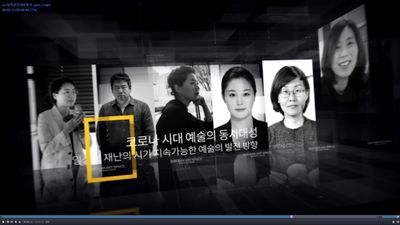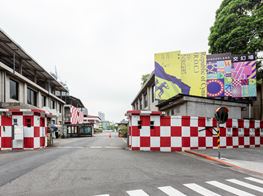UNESCO's ResiliArt Movement Inspires Asia Art Space Network Forum
In Partnership with C-LAB and Asia Culture Center
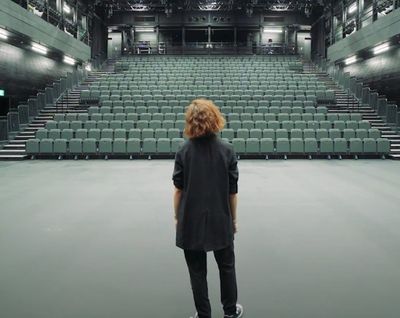
Rosa Velasco, An Invitation: On Empty Theatre (2020) (still). Organised by West Kowloon Cultural District, Hong Kong. Courtesy West Kowloon Cultural District.
'In these unstable and uncertain times, we need to look to the things that unite us; the things that show us the world in all of its variations. And for that, we need artists.' These were the stirring words of UNESCO Director-General Audrey Azoulay at the launch of the global art movement ResiliArt on 15 April 2020, World Art Day.
The launch of ResiliArt inspired the framework for this year's Asia Art Space Network (AASN). Initiated by the Ministry of Culture, Sports and Tourism of Korea in 2012, AASN normally invites 30 non-governmental organisations of various sizes in Asia every year to meet and exchange ideas. Because of the Covid-19 pandemic, the 2020 event—jointly organised by the Taiwan Contemporary Culture Lab (C-LAB), Asia Culture Center, and the Asia Culture Institute (ACI)—shifted online to explore the relationship between art, resilience and the future of the art world post-pandemic.
Held on 23 October 2020, the forum was divided into two morning and afternoon sessions, titled 'What makes museums and theatres social again? – Assembling in the post COVID-19 era' and 'Resilient Art – for the Artist, by the Artist' respectively. While the digital platform was tested well in advance of the event, unforeseen circumstances were inevitable in the connection of network signals from different countries, highlighting the value and stability of in-person meetings.
While most art events have been postponed or cancelled over the last six months as a result of the pandemic, C-LAB Executive Director Lai Hsiang-Ling started the morning session talking about the exhibitions and activities organised by C-LAB in 2020. Lai counted 166 exhibitions featuring 200 groups of creators and 264,525 visitors attending the art centre, reflecting Taiwan's effective response to the spread of Covid-19.
Lai went on to discuss plans to demolish the walls surrounding the former Air Force Headquarters where C-LAB is located, marking the transition of the grounds as a site of open experimentation.
Among C-LAB's adjustments to the pandemic was the launch of an online live broadcast space, as well as the #Stream C-LAB project, which provided assistance to creators to continue their production plans and venue, funding, and technical support to selected proposals. Seven selected individuals and groups were invited to stream their creations online between September and November 2020, presenting works in varying formats, such as experimental sound, dance, and role play.
Earlier in the summer, the exhibition Fictional Life: Hybridity, Transgenetics, Innovation (6 June–27 July 2020) explored the connections between art, technology, and science, with a forum of online discussions organised in response to the pandemic that considered how the virus could inspire art, and how we might learn to co-exist with viruses in the future. Among them, Lin Pei-Ying presented Virophilia (2020), in which audiences were gathered via video software to listen to instructions and eat 'viral' food designed by the artist.
Following Lai Hsiang-Ling's opening speech, curator Emily Sexton discussed her pre-Covid-19 collaboration with Campbelltown Art Centre to present BLEED (22 June–30 August 2020), a festival that explores the auditory and visual experiences of being online. With the current instalment prolonged due to the pandemic, the festival spanned ten weeks and featured 23 writers, 70 artists, and 99 newly commissioned works.
'Much to our surprise, the festival became an online sensation because most audiences remain connected to the artists whom they've already known', Sexton observed, who pointed out that the pandemic has highlighted the possibility of running an art festival for a longer duration in the future.
'We thought of "live" as a noted co-presence with others—a layering of experiences that is multifold', Sexton said. But she was also concerned with the dramaturgy of different platforms. 'As curators, we should be cautious of dragging a work from its former medium to a new one unless the artist is interested in that.'
National Gallery Singapore's director of curatorial and collections, Russell Storer, highlighted that art institutions in Singapore closed on 4 April 2020, with the Gallery reopening on 26 June 2020 with an exhibition of formative works by Malaysian modernist painter, Latiff Mohidin (27 March–27 September 2020). Prior to this, nearly half of the visitors to the Gallery, which opened to the public five years ago, were tourists; now, they are mostly local due to the pandemic.
The museum launched the online project, 'Gallery Anywhere', providing digitised exhibition content and collections—a family friendly project with a 360-degree panoramic viewing feature. The Singapore government has also provided the museum additional funding to support the improvement of its virtual programming.
In lieu of cancelled exhibitions, the National Gallery Singapore and Singapore Art Museum also partnered with ten other local art institutions, such as Coda Culture and soft/WALL/studs, for the collective project Proposal for Novel Ways of Being (August 2020–February 2021), which explored ways of experiencing art online and offline.
Eriko Kimura, curator at the Yokohama Museum of Art, shared her insights on the current situation in Japan, noting a turn 'towards conservatism, especially after the coronavirus outbreak'. Reflecting on these conditions, Kimura supposed this 'phenomenon is not unique to Japan but is felt around the globe'.
Kimura wondered how institutions might respond to 'two extremes' while being mindful of local audiences—'on the one hand, art institutions in Japan would prefer local and vernacular works; on the other hand, some artists would gear towards overseas exhibiting opportunities.'
Thinking about how institutions and individuals can respond to complex times, Low Kee Hong, the director of theatre programmes at West Kowloon Cultural District Hong Kong, was adamant: 'To say that art is not essential in the age of pandemic could not be more wrong. It is important to protect—to really protect the art space that we're already in. If art is absent from our future existence, we will be in big trouble.'
Broadcast from ACC, the afternoon session featured Hee-young Kim, assistant professor at the Department of Art, Kookmin University; So Hyun Park, from Seoul National University of Science and Technology; Na-Kyung Kang, the director of the artist-run space Seetangraum; Sang-ho Seo, programme director of Korean art space OpenSpace Bae; independent curator Jongeun Lim, artistic director Inza Lim, and artist Young-ju Jang.
Departing from the previous session, the afternoon's speakers considered the role of art during the pandemic. Hee-young Kim's presentation discussed parallels between the current situation and the context of the Dadaists, who rebelled against rational tradition after World War I. Kim emphasised the importance of departing from 'self-centred perspectives' in order to embrace difference and understand 'the world in relational terms', with art institutions potentially paving the way for new disciplines 'to transform the old ways.'
The need for agility and responsiveness has come through in the way Asia has handled the pandemic comparatively better than the Western world. Instead of counting on the vaccine and returning to the pre-pandemic way of life, Na-Kyung Kang emphasised the importance of focusing on the present, and 'communicating and exploring our options'.
Speaking about the artist-run space Seetangraum, Kang described the development of an auto-pilot operation, whereby audiences receive an encrypted key code, which they can use to access the exhibition space, where contact tracing measures such as temperature checks and ID registration forms, allow exhibitions to continue as usual.
In Korea, curator Jongeun Lim noted that some live performances have been able to continue, but social distancing compromises the possibility for high-quality performances. In response, Lim's recent project, THE NEXT STATION TO OUR FOREST (September 2020–March 2021) presented works by Young-il Wi, HON ZI, and Zoohyeong Song in a café at Yeongdeungpo Market Station of Seoul Subway Line 5 into an alternative art space.
Resonating with the subtitle For Artists and By Artists, the conference ended with artist Young-ju Jang expressing that there have always been crises, and that regardless, art spaces change over time. As art spaces seem to become more intertwined with politics, society, and culture in the age of no contact, this interlinking is set to redefine how art might develop in the future.—[O]
Translated by Joanne He Yongxuan.

